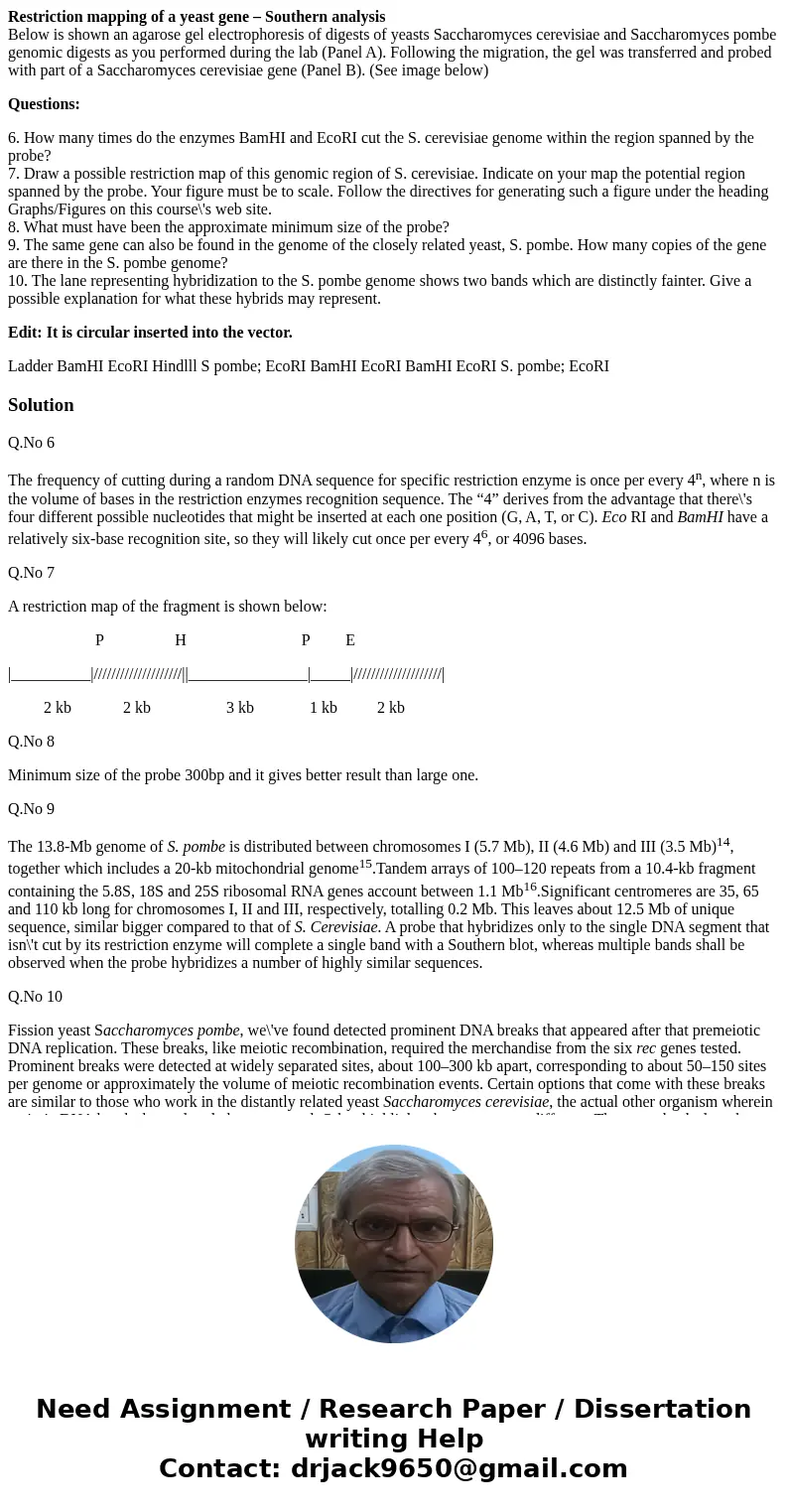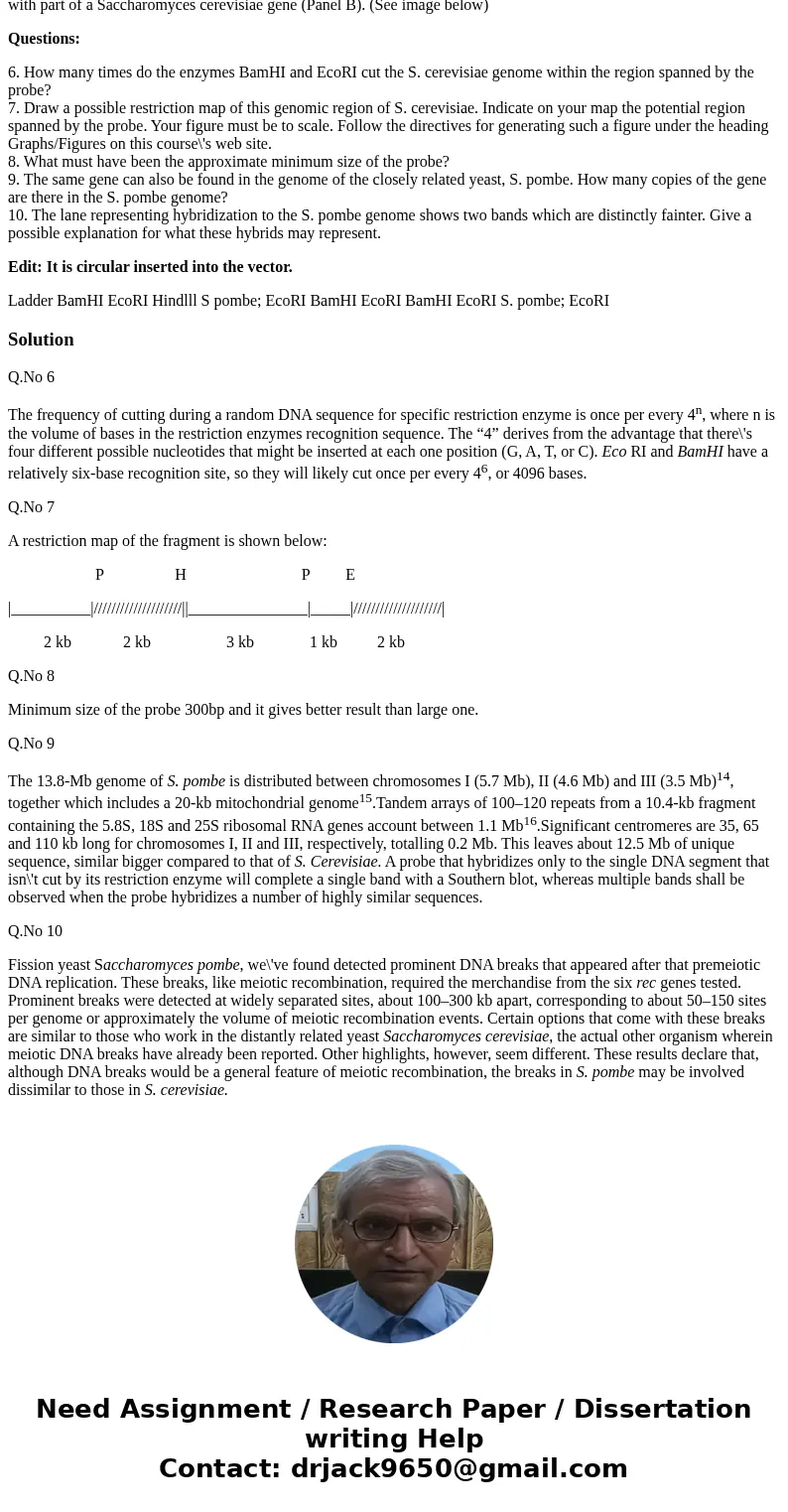Restriction mapping of a yeast gene Southern analysis Below
Restriction mapping of a yeast gene – Southern analysis
Below is shown an agarose gel electrophoresis of digests of yeasts Saccharomyces cerevisiae and Saccharomyces pombe genomic digests as you performed during the lab (Panel A). Following the migration, the gel was transferred and probed with part of a Saccharomyces cerevisiae gene (Panel B). (See image below)
Questions:
6. How many times do the enzymes BamHI and EcoRI cut the S. cerevisiae genome within the region spanned by the probe?
7. Draw a possible restriction map of this genomic region of S. cerevisiae. Indicate on your map the potential region spanned by the probe. Your figure must be to scale. Follow the directives for generating such a figure under the heading Graphs/Figures on this course\'s web site.
8. What must have been the approximate minimum size of the probe?
9. The same gene can also be found in the genome of the closely related yeast, S. pombe. How many copies of the gene are there in the S. pombe genome?
10. The lane representing hybridization to the S. pombe genome shows two bands which are distinctly fainter. Give a possible explanation for what these hybrids may represent.
Edit: It is circular inserted into the vector.
Ladder BamHI EcoRI Hindlll S pombe; EcoRI BamHI EcoRI BamHI EcoRI S. pombe; EcoRISolution
Q.No 6
The frequency of cutting during a random DNA sequence for specific restriction enzyme is once per every 4n, where n is the volume of bases in the restriction enzymes recognition sequence. The “4” derives from the advantage that there\'s four different possible nucleotides that might be inserted at each one position (G, A, T, or C). Eco RI and BamHI have a relatively six-base recognition site, so they will likely cut once per every 46, or 4096 bases.
Q.No 7
A restriction map of the fragment is shown below:
P H P E
|__________|////////////////////||_______________|_____|////////////////////|
2 kb 2 kb 3 kb 1 kb 2 kb
Q.No 8
Minimum size of the probe 300bp and it gives better result than large one.
Q.No 9
The 13.8-Mb genome of S. pombe is distributed between chromosomes I (5.7 Mb), II (4.6 Mb) and III (3.5 Mb)14, together which includes a 20-kb mitochondrial genome15.Tandem arrays of 100–120 repeats from a 10.4-kb fragment containing the 5.8S, 18S and 25S ribosomal RNA genes account between 1.1 Mb16.Significant centromeres are 35, 65 and 110 kb long for chromosomes I, II and III, respectively, totalling 0.2 Mb. This leaves about 12.5 Mb of unique sequence, similar bigger compared to that of S. Cerevisiae. A probe that hybridizes only to the single DNA segment that isn\'t cut by its restriction enzyme will complete a single band with a Southern blot, whereas multiple bands shall be observed when the probe hybridizes a number of highly similar sequences.
Q.No 10
Fission yeast Saccharomyces pombe, we\'ve found detected prominent DNA breaks that appeared after that premeiotic DNA replication. These breaks, like meiotic recombination, required the merchandise from the six rec genes tested. Prominent breaks were detected at widely separated sites, about 100–300 kb apart, corresponding to about 50–150 sites per genome or approximately the volume of meiotic recombination events. Certain options that come with these breaks are similar to those who work in the distantly related yeast Saccharomyces cerevisiae, the actual other organism wherein meiotic DNA breaks have already been reported. Other highlights, however, seem different. These results declare that, although DNA breaks would be a general feature of meiotic recombination, the breaks in S. pombe may be involved dissimilar to those in S. cerevisiae.


 Homework Sourse
Homework Sourse